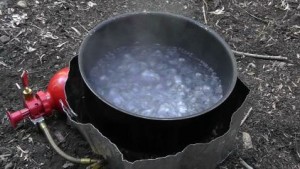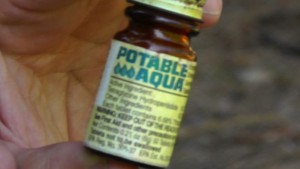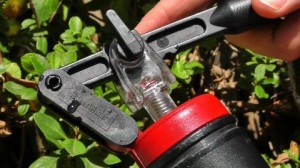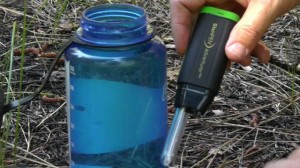Water Purification Learning Objectives
After completing this section you should be able to:
- Explain why water purification is important
- Purify water by boiling
- Purify water by chemically treating
- Purify water by filtering
- Purify water by zapping with ultraviolet light
- Explain the pros and cons of each purification method
Explain why water purification is important
How safe is the water?
Telling you that water in the wilderness is safe to drink is not a risk most people are willing to take. Even if field research shows the actual risk of infectious organisms is relatively low, the legal risk is arguably high, so the standard advice will almost always be “treat all water as suspect”. To heighten our fear, there is a long list of completely invisible to the eye pathogens you would probably not want to put into your body, including various bacteria, parasites, and viruses. To make them even scarier, they have nasty sounding names like: giardia lamblia, cryptosporidium, escherichia coli, salmonella, campylobacter jejuni, hepatitis-A and on and on. Many of the symptoms from these ailments, such as diarrhea, take time to revel themselves. In fact, you may be well outside the wilderness before you even realize you have a problem.
Although the risk of infection may or may not be exaggerated, the good news is there are plenty of water treatment options available which make following the safety advice relatively easy. Current water treatment options fall into four categories: boiling, chemically treating, filtering, and zapping with ultraviolet light.
Purify water by boiling

The least expensive and most effective solution is boiling. Boiling will kill bacteria, parasites, and viruses. Many people advise bringing water to a hard boil for 5 minutes, and perhaps longer at higher elevation. More current literature, however, suggests merely reaching the boiling is sufficient and effective. The downside of boiling of course is inconvenience. To boil water you must set up a stove, consume fuel, wait for it to boil, and once boiled, wait some more for it to cool down so you can drink it. Boiling is probably a more practical approach when you are in camp for cooking anyway, but not as easy to deploy when traveling on the trail.
Purify water by chemically treating

Water can be effectively disinfected with Halogens, the most common being iodine and chlorine. Both are available in liquid or tablet form, and are very inexpensive and easy to carry. To be effective, however, you need to carefully follow the instructions, paying particular attention to the inter-relationship of the water clarity, water temperature, the concentration of the halogen, and the duration of treatment. If the water is cold or cloudy, you will have to increase either the concentration or the time of treatment.
The most significant downside to halogens is the taste. This is particularly important when traveling with children. If the water tastes bad to them they will be far less likely to drink it, and the risk of dehydration will increase dramatically. After treatment (not during), you may want to add flavorings to mask the taste, and increase consumption.
Purify water by filtering

By forcing water through very tiny pores (say .2 microns), you can filter out many of the parasites, including Giardia. Filters are not, however, typically effective against viruses. The main advantage with filtering, is that you can consume the filtered water immediately. Unlike chemicals, there is no waiting for treatment, and unlike boiling, the water remains as cool and refreshing as the source. In fact, many of the cartridges (either paper or ceramic) contain charcoal to further “sweeten” the water. The downside to filters is that they are heavier, bulkier, and more expensive than other solutions. Many find the convenience on the trail, clean taste well worth the cost and effort.
NOTE: If you are in an area where viruses are a concern, you will need to chemically treat the water after it is filtered.
Purify water by zapping with ultraviolet light

Used for quite a while in commercial water treatment centers, the ultraviolet light technology has improved and streamlined to the point of being practical for outdoor enthusiasts. Small hand held devices, which can be carried on your belt, will effectively treat water directly in your water bottle in under 2 minutes. Like filtering, “zapping” water with UV light has no negative after taste. The device is also lighter, and less bulky than filters. One downside is that they are based on electronic technology, requiring an ongoing supply of batteries, and the device could be damaged in the field by dropping. I would not rely on a UV light as my only source of treatment, but it is very convenient for a few quick bottles along the trail.
Have a Backup Plan
You can see there are pro’s and con’s of each of the water treatment methods. Because your preferred method may fail in the field (pump break, UV device fizzle out, fuel not available, etc) make sure you have a backup option. Many people carry Halogens as their back up treatment solution. Just ensue whatever methods you are counting on, you are well experience and familiar with using in the field.
Water Purification Review
You should be able to:
- Explain why water purification is important
- Purify water by boiling
- Purify water by chemically treating
- Purify water by filtering
- Purify water by zapping with ultraviolet light
- Explain the pros and cons of each purification method
To review your skills, select the Water Purification Quiz:


One thought on “Water Purification”